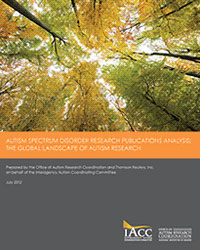Publications Analysis
Autism Spectrum Disorder Research
The Global Landscape of Autism Research
2012
Publication Output and Trends in Subcategories of Autism Treatments and Interventions Research

Figure 11. Publication Output and Trends in Subcategories of Autism Treatments and Interventions Research. The pie graph (top) illustrates relative proportions of research articles published in 2010 on seven subcategories of ASD Treatments and Interventions research and the line graph (bottom) shows the change in number of publications in each subcategory over time, from 1980 to 2010. The most prolific areas include research on Behavioral, Medical/Pharmacological, Technology-Based Interventions and Supports and Educational interventions. Overall, the number of publications in all subcategories has been increasing since 1999-2000, with a steeper rise beginning in 2005 to 2006. Publications in this figure include both primary and secondary research. See Figure A-30 in Appendix I for publication output by primary research only.
Treatments and Interventions research is one of the highest priority areas for people with autism and their families, as the development of effective treatments and interventions has the potential to reduce disability and significantly enhance quality of life. A wide variety of autism treatment and intervention approaches exist that are designed to reduce disabling symptoms and increase functional skills and abilities, and there is a growing body of research to support the use of particular treatment and intervention approaches. Even so, there is pressing need for a stronger evidence-base across the range of intervention options that are actively used in the home and community. Moreover, researchers are exploring new ways to enhance language skills, communication, and social abilities in people with autism, as well as address the host of medical issues, such as seizures, sleep disorders, and gastrointestinal difficulties, that commonly co-occur with the core features of ASD.
Numerous types of treatment and intervention approaches appearing in the research literature were identified and compiled into one of seven general subcategories that fall under the Treatments and Interventions umbrella:
- Behavioral: Behavioral intervention research involves a wide array of behavioral therapy and training methods, including applied behavior analysis (ABA), cognitive-behavioral therapy, discrete trial training, Early Start Denver Model, imitation training, joint attention training, Lovaas method, pivotal response training, sibling-mediated interventions, and social skills training.
- Complementary, Dietary, and Alternative: Some examples in this group include research on acupressure, acupuncture, antioxidants, cholesterol supplementation, nutritional supplements (e.g., vitamins and minerals), probiotics, and special diets (e.g., gluten-free, casein-free).
- Educational: Nearly all ASD research conducted in the classroom falls under this subcategory, including curricula, education methods and best practices, inclusive education programs, math and reading training, positive behavioral supports, special education programs, and other behavioral interventions developed for and tested in educational settings.
- Medical/Pharmacologic: This subcategory includes clinical research on drugs (e.g., antidepressants, anticonvulsants, antipsychotics, anxiolytics, hormones, and stimulants) to treat autism and its co-occurring conditions, as well as clinical interventions such as transcranial magnetic stimulation (TMS).
- Model Systems/Therapeutic Targets: Research in this subcategory includes the development of animal models that mimic behaviors of ASD, and using animal and cellular models to identify therapeutic targets or test new drug treatments.
- Occupational, Physical, and Sensory-Based Therapies: Therapies in this subcategory encompass art therapy, motor training (including fine motor skills such as handwriting as well as gross motor training involving balance and posture), music therapy, occupational therapy, pet (animal) therapy, physical activity plans and exercise therapy (bike riding, swimming), physical therapy, sensory integration, therapeutic horseback riding, training in self-care and daily living skills, and vocational rehabilitation.
- Technology-Based Interventions and Supports: Augmentative and alternative communication (AAC), computer applications and software, picture exchange communication systems (PECS), social robots, teleconferencing, video modeling, virtual reality (including virtual and 3D environments to mimic social situations), and wearable sensors are all examples of the types of technology in this subcategory of publications.
Publications, which include both primary and secondary research, related to Behavioral interventions comprised the largest share of ASD research in 2010 (26%), followed by articles on Medical/Pharmacological treatments (18%) and Technology-Based Interventions and Supports (18%). In the late 1980s and early 1990s, the two research categories of Behavioral and Medical/Pharmacologic interventions had approximately equivalent publication counts; however, Behavioral intervention research publications experienced a sharp increase around 1999.
Along with the general growth in the autism research field that was catalyzed by many factors, some of which are discussed in Chapter One of this report, many specific advances and events may have contributed additionally to the rapid growth of publications on Behavioral interventions during the time frame studied. For example, in 1987, a pivotal publication authored by Ivar Lovaas and colleagues helped establish the Lovaas approach/early intensive behavioral intervention as one of the most used and most effective forms of Applied Behavioral Analysis (ABA) in the treatment of children with autism.16 In 1999, a key follow-up study by Tristram Smith and colleagues confirmed favorable treatment outcomes and spurred additional research on early intensive behavioral intervention.17 Also notable, one of the first general ABA treatment manuals was published in 1996, "Behavioral Intervention for Young Children with Autism: A Manual for Parents and Professionals," and soon after in 1998, the Behavior Analyst Certification Board (BACB), a certification body for practitioners of ABA, was established.18
In the last few years, the steepest increase in publication activity among all the research categories has occurred within Technology-Based Interventions and Supports. With continuing advances in technology driving this category, this trend will likely continue. The four research areas with the smallest proportion of publications in 2010 – research in Educational settings (12%), Model Systems/Therapeutic Targets (10%), Occupational, Physical, and Sensory-Based (8%) and Complementary, Dietary, and Alternative (8%) – all started to demonstrate appreciable growth around 2005, more recently than the larger subcategories. These all appear to be emerging areas of research that may continue to exhibit strong growth in the coming years. Similar publication output trends were observed when the analysis was restricted to primary research articles only. See Figure A-30 in Appendix I for more details.




